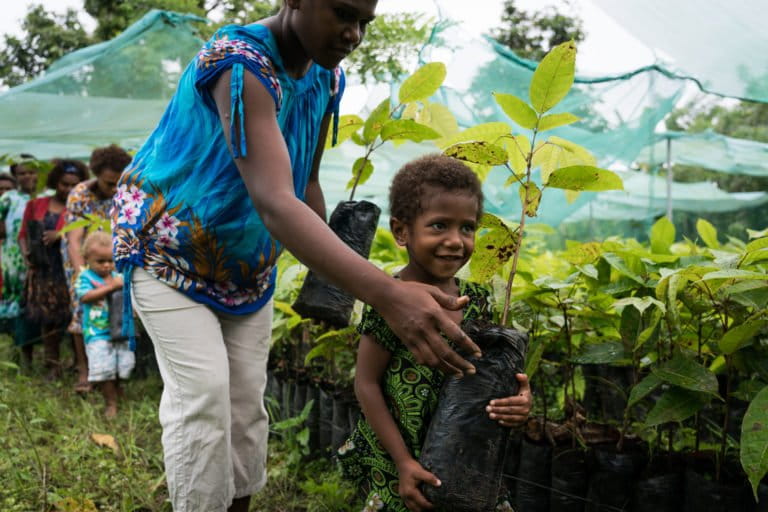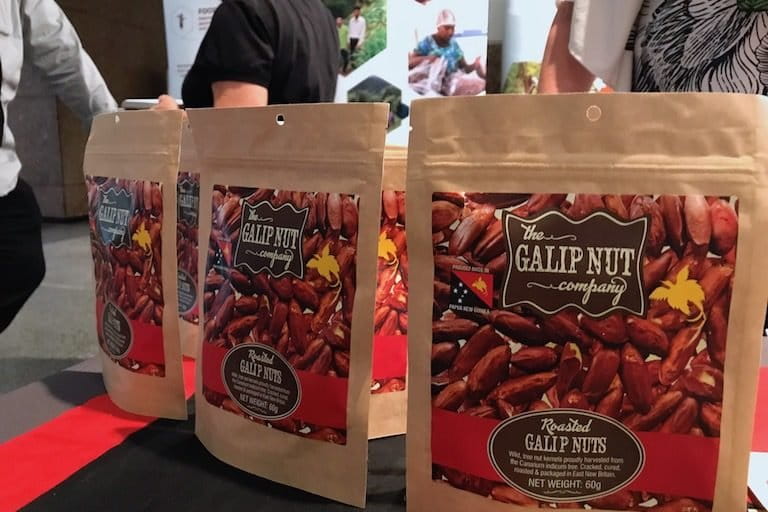
- Galip nuts are a well-known, traditional agricultural product in Papua New Guinea (PNG).
- Papua New Guineans are currently reaping the economic and environmental benefits of this nut via agroforestry led by local communities and women entrepreneurs.
- In this episode, we speak with Dorothy Devine Luana, PNG-based owner of DMS Organics, a galip nut grower and processor, and Nora Devoe, research program manager for a project of the Australian Centre for International Agricultural Research (ACIAR), focused on the potential of the galip nut industry to sustainably empower PNG communities.
The seventh and final episode of the Mongabay Explores podcast series about New Guinea examines the growing galip nut industry and the many social, economic and environmental benefits this agricultural product has for Papua New Guinea:
Listen here:
Globally, the edible nut industry will be worth an estimated $2 billion by 2025. In Papua New Guinea, the nut of choice is the galip nut (Canarium indicum), which looks like an almond and is easily stored and transported. That means the potential for tapping into the increasing global demand for nut-based products is huge for the island nation, where the galip nut is already making a difference in improving the quality of life for more than 1,000 smallholder farms.

Mongabay speaks with Dorothy Devine Luana, an entrepreneur from the province of East New Britain, whose company grows galip nuts using agroforestry, a farming technique rooted in traditional knowledge that grows multiple cash crops alongside woody perennials. By producing and processing galip nuts and galip nut products, her company, DMS Organics, is bringing alternative and additional income streams to her smallholder farm and to her community.
Luana’s success with her company is one example of many in PNG where local women-led businesses are reaping benefits from more than a decade of research and development aided by the Australian Centre for International Agricultural Research (ACIAR) and the National Agricultural Research Institute (NARI).
We also speak with Nora Devoe, research program manager at ACIAR, which has been supporting this project that seeks to understand the viability and potential of the galip nut to drive the canarium industry in PNG and foster new markets for farmers to sell the crop. Devoe speaks about ACIAR’s research and training provided to locals to better harvest, process and sell their nuts, plus the potential of the crop to empower PNG entrepreneurs.

Mongabay Explores is an ongoing episodic podcast series about the world’s unique places and species. Each season dives into new areas of amazing natural heritage, their environmental challenges and conservation solutions. This season, it’s explored the great biodiversity and cultural richness of New Guinea. If you missed the first six episodes in this season, you can listen to them here.
Sounds heard during the intro and outro include the following: rusty mouse-warbler, growling riflebird, raggiana/lesser bird-of-paradise, superb fruit-dove, long-billed honeyeater, little shrike-thrush, brown cuckoo-dove, black-capped lory. Special thanks to Tim Boucher and Bruce Beehler for identifying them.
Soundscape credit: recorded in the Adelbert Mountains in Papua New Guinea by the communities of Musiamunat, Yavera and Iwarame in partnership with The Nature Conservancy and Zuzana Burivalova/Sound Forest Lab.
If you enjoy Mongabay’s podcasts, we ask that you please consider becoming a monthly sponsor via our Patreon page, at patreon.com/mongabay. Just a dollar or more per month helps us offset production costs and hosting fees, and can help us create special series like Mongabay Explores.
Subscribe to Mongabay Explores on Spotify, Apple, Google, or wherever you get podcasts. Listen to all of the Mongabay Explores podcast episodes via the Mongabay website here.
Banner Image: Tinganagalip Women Cooperative Group member Elizabeth Tiniu carries canarium seedlings out of the groups greenhouse. Image by Conor Ashleigh.
Mike DiGirolamo is Mongabay’s audience engagement associate. Find him on Twitter @MikeDiGirolamo, Instagram, or TikTok via @midigirolamo.

Podcast: Community empowerment and forest conservation grow from the galip nut in Papua New Guinea
Source: Trends News

0 Comments